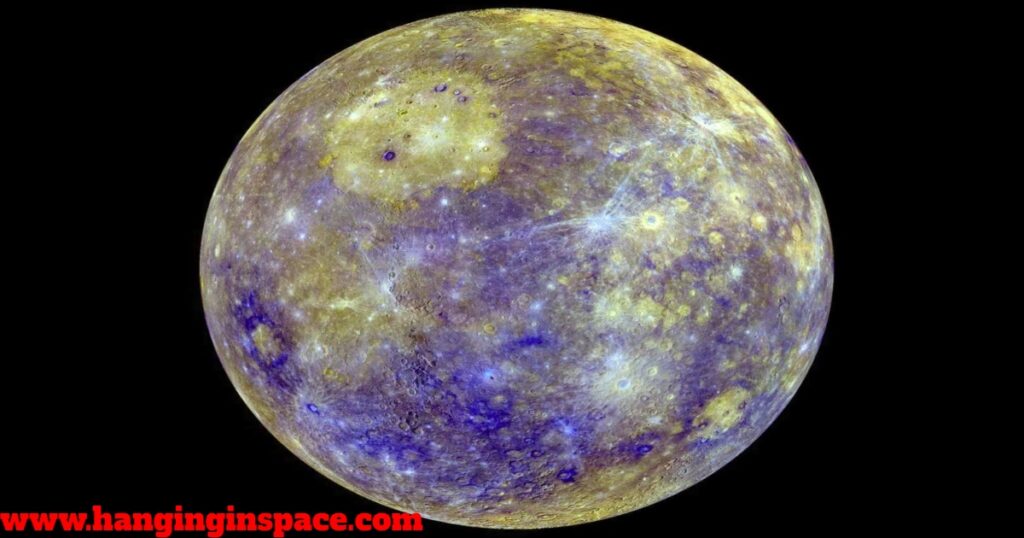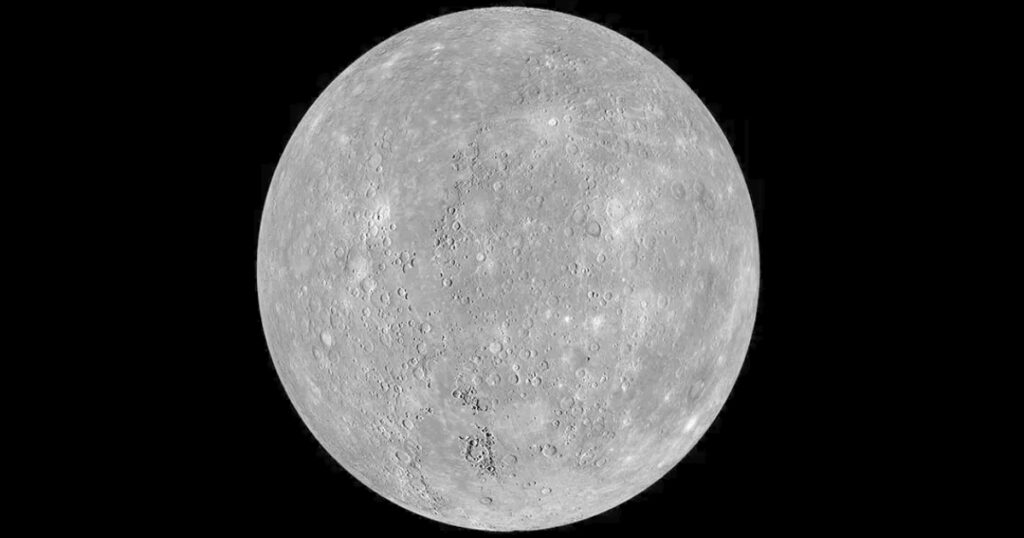Mercury is the smallest planet in the solar system and it is the closest one to the Sun. It’s a rocky planet with a cratered surface, similar to our Moon. Despite its proximity to the Sun, Mercury isn’t the hottest planet as compared to Venus.
However, due to its slow rotation and lack of atmosphere, Mercury experiences dramatic temperature swings, with scorching days and freezing nights.

What is the Size of Mercury?
Mercury’s radius is approximately 2,440 kilometers (1,516 miles). Mercury’s diameter is around 4,880 kilometers (3,032 miles). Mercury’s circumference is about 15,329 kilometers (9,525 miles).
What is the Mass and Volume of Mercury?
Mercury boasts a mass of approximately 3.3 x 10^23 kilograms and its volume is approximately 6.083 × 10^10 cubic kilometers (km³).
What is the Temperature of Mercury?
Mercury’s orbit around the Sun takes only 88 Earth days, making it the quickest planet in our solar system. Mercury lacks a discernible atmosphere. The lack of a protective blanket causes an extreme temperature change.
The sunlight side has a temperature of 800°F (430°C), which is hot enough to melt lead. However, on the dark side, temperatures drop to -290°F (-180°C), and Mercury’s thin exosphere, a wispy layer of particles, provides little shelter from the Sun’s heat and the harsh cold of space.
What is Mercury’s Average Distance from the Sun & Earth?
In terms of its distance from the Sun, Mercury orbits at an average distance of about 36 million miles (58 million kilometers) or 0.39 AU. Mercury’s average distance from Earth is about 77 million kilometers (48 million miles).
How long does it take Mercury to Orbit the Sun?
It takes Mercury only 88 Earth days to orbit the Sun. This makes it the fastest planet in our solar system.
How long does it take Mercury to Spin on its Axis?
One full rotation on Mercury takes 59 Earth days.
Gravitational Field Strength:
The surface gravity on Mercury is approximately 3.7 m/s² (meters per second squared). This is about 38% of Earth’s surface gravity (which is 9.81 m/s²).
Escape Velocity:
The escape velocity required to leave the gravitational pull of Mercury is approximately 4.25 kilometers per second (km/s).
Mercury does not have any moons. It is one of the two planets in our solar system, along with Venus, that does not have any natural satellites orbiting around it.
What is the Composition of Mercury?
Scientists believe Mercury formed about 4.6 billion years ago alongside the rest of the solar system. During its formation, the young planet was bombarded by intense heat and radiation from the Sun. This intense heat is thought to have vaporized lighter elements like hydrogen and helium, leaving behind a denser, iron-rich core.
Iron:
Iron makes up 70% of Mercury’s mass, forming its large, metallic core.
Oxygen:
The second most abundant element, but not in the form of breathable air. It’s likely locked up in minerals like oxides on the surface.
Silicon:
This element, along with others like sulfur, magnesium, and aluminum, makes up the silicate mantle and crust.
Trace Elements:
Small amounts of elements like sodium, potassium, and zinc are also present.
What is the Interior Structure of Mercury?
Scientists use a variety of techniques to infer its internal structure. These techniques include studying the planet’s density, rotation, and magnetic field. Here’s what we believe lies beneath the surface:
Massive Core:
Mercury’s high density suggests a core that makes up a much larger proportion of the planet compared to other solar system bodies. Estimates suggest the core is about 85% of Mercury’s radius. This core is believed to be composed primarily of iron, likely in a liquid state due to the extreme heat.
Thin Mantle:
Surrounding the core is a thin silicate mantle, much thinner than Earth’s mantle. This mantle is thought to be solid and likely plays a role in the planet’s magnetic field generation.
Cratered Crust:
The outermost layer is a thin, heavily cratered crust composed of silicate rocks. Billions of years of meteorite impacts have left their mark on Mercury’s surface, creating the vast plains and craters we see today.

Mercury’s Exosphere:
Mercury lacks an atmosphere, but it does have a thin layer of atoms called the exosphere that are blasted off the surface by the solar wind and colliding meteoroids. The primary elements found in Mercury’s exosphere are oxygen, sodium, hydrogen, helium, and potassium.
What is Mercury’s Magnetosphere?
Mercury has a weak magnetosphere, generated by its partially molten iron core. It is much smaller than Earth’s magnetosphere and offers limited protection from the solar wind.
How is Mercury’s Magnetic Field?
Mercury possesses a surprisingly strong magnetic field, though much weaker than Earth’s. One theory suggests that the liquid iron core generates a weak magnetic field through a dynamo effect similar to Earth’s. Another theory proposes that the interaction of the solar wind with Mercury’s exosphere plays a role in creating the magnetic field.
Mercury’s Formation:
Mercury, the smallest and innermost planet in our solar system, formed approximately 4.6 billion years ago through a process called accretion. During the early stages of the solar system’s formation, tiny grains of dust and gas began to clump together due to gravitational attraction. These clumps, or planetesimals, collided and merged over time, gradually forming larger bodies known as protoplanets.
Mercury’s formation likely involved numerous collisions and mergers of planetesimals, eventually resulting in the creation of a protoplanet that grew to become the planet we know today. However, unlike some of the larger planets,
Mercury did not accumulate a massive atmosphere or retain significant amounts of volatile substances, such as water or gases. This is thought to be due to its close proximity to the Sun, where intense solar radiation and solar winds stripped away its atmosphere and volatile materials early in its history.
As a result, Mercury is composed mainly of rocky materials, with a dense metallic core that makes up a large portion of its mass. Despite its small size and harsh surface conditions, Mercury’s formation provides valuable insights into the early history and processes of planet formation in our solar system.

When and Who Discovered Mercury?
Mercury, the innermost planet in our solar system, has been known since ancient times. Its discovery cannot be attributed to a single individual, as it was observed by various ancient civilizations, including the Babylonians, Egyptians, Greeks, and Chinese. However, it was not until the invention of the telescope in the 17th century that astronomers were able to make more detailed observations of Mercury’s movements and characteristics.
One of the most notable astronomers to study Mercury was Johannes Kepler, who accurately described its orbit in the early 17th century.
Further advancements in telescopic technology allowed astronomers to study Mercury’s surface features and gather more information about its composition and behavior. Today, Mercury continues to be a subject of study for astronomers and planetary scientists, providing valuable insights into the formation and evolution of our solar system.
Mercury’s Exploration:
Missions like NASA‘s MESSENGER spacecraft have provided valuable data on the planet’s composition, surface features, and magnetic field. Future missions, like the proposed BepiColombo mission by the European Space Agency and JAXA (Japan Aerospace Exploration Agency), aim to further explore this planet.
Mercury as compared to Venus:
Mercury Vs. Venus
| Feature | Mercury | Venus |
|---|---|---|
| Planet Type | Terrestrial Planet | Terrestrial Planet |
| Distance from Sun | 35.98 million km (0.39 AU) | 108.2 million km (0.72 AU) |
| Diameter | 4,879 km | 12,104 km (Earth = 12,742 km) |
| Atmosphere | Thin, tenuous exosphere | Thick, dense atmosphere of carbon dioxide |
| Surface Temperature | -173°C to 430°C (extreme swings) | 462°C (hotter than Mercury’s daytime) |
| Rotation Period | 58.6 Earth days (longer than its year) | 243 Earth days (slowest in the solar system) |
| Revolution Period | 88 Earth days | 224.7 Earth days |
| Moons | None | None |
| Notable Features | Craters, scarps, cliffs | Volcanic features, plains, thick atmosphere |
Conclusion:
Mercury’s lack of a large atmosphere results in a world of extreme temperature fluctuations. The blazing heat on the sunny side and the freezing blackness on the night side depict a planet in continual conflict with the Sun’s relentless radiation.
